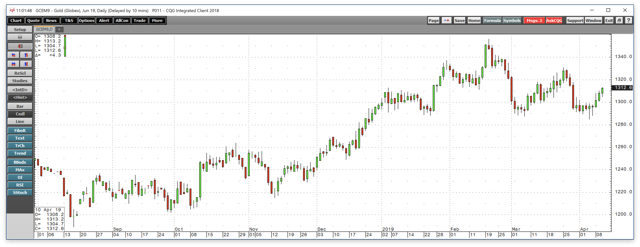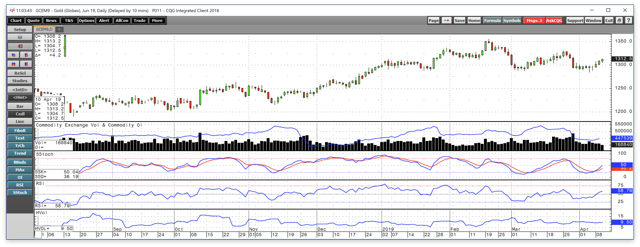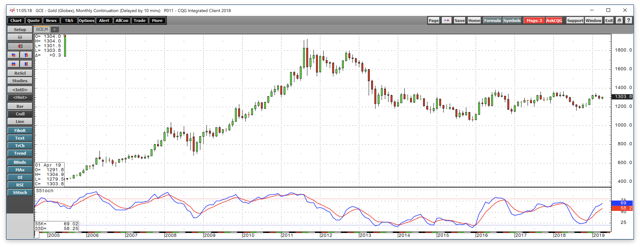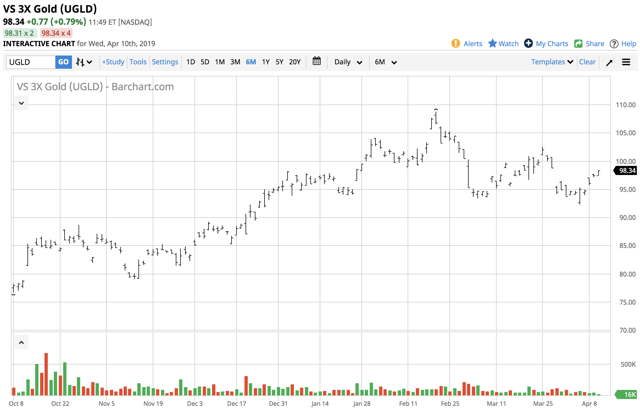Signs Of Life In Gold
Gold bounces with the June contract back over $1300 per ounce.
Technical metrics tell us the correction could be over.
Official sector buying continues to underpin the gold market - a move in Italy that could start a trend.
Uncertainty in the world supports a higher price for gold.
UGLD for an aggressive approach to the gold market.
In mid-February, the price of nearby COMEX gold futures moved to a high at $1344 per ounce, and they looked like it was only a matter of time before they would rise past the 2018 and 2016 highs. Gold always looks its best on the highs and worst on its lows. The shine on gold dulled in the weeks that followed the 2019 peak, taking the price of the precious metal to a low at $1279.50 during the first week of April.
On April 10, gold was moving away from the $1300 level on the upside, and there are signs that the corrective move that took the precious metal $64.50 lower is coming to an end. Gold has made higher lows, and higher highs since the price fell to its lowest level since early 2017 at $1161.40 last August. If $1279.50 turns out to be a higher low, gold could be preparing to make an earnest challenge of the 2018 peak at the double top at $1365.40 from January and April last year. Above there, the critical level of technical resistance on the upside stands at the 2016 post-Brexit peak at $1377.50 per ounce.
If gold is done with the downside and we are on the verge of a move higher, the VelocityShares 3X Long Gold ETN product (UGLD) could be the perfect product for those seeking leverage who do not venture into the futures arena.
Gold bounces with the June contract back over $1300 per ounce
After trading to a low at $1284.90 on the active month June COMEX futures contract on April 4, the price of the yellow metal rose to over the $1313.20 level on April 10 at last glance. 
Source: CQG
As the daily chart highlights, after a head fake move that took gold to a marginally lower low below the March 7 bottom at $1287.50 that took gold to $1284.90 on April 4, the price turned higher and is now in a position to build on the recent gains. The technical and fundamental pictures for the precious metal are supportive of even more gains in the coming days and weeks.
Technical metrics tell us the correction could be over
Gold got down to a level where the technical metrics were flashing that it was at a bottom and the prospects for another move to the upside were on the horizon. 
Source: CQG
The daily chart illustrates that both price momentum and relative strength indices moved to oversold territory during the most recent corrective move to the downside. Moreover, open interest, which is the total number of open long and short positions in the COMEX futures market, declined from 524,865 contracts on March 25 when June gold was at the $1330 level to a low at 435,913 on April 5, a drop of 16.9%. The decrease in the open interest metric as the price of gold was correcting lower was not a technical validation of an emerging bearish trend in the gold market which was a sign that a bottom was in the cards sooner, rather than later.
Official sector buying continues to underpin the gold market - a move in Italy that could start a trend
It is no secret that governments around the world have been net buyers of gold over the past years with Russia and China leading the way when it comes to purchases. Both nations are leading producers, and they have been increasing their reserves by absorbing domestic output while making occasional purchases of the yellow metal in the international market.
A recent move in Italy could start a trend when it comes to the gold reserves of EU members. Italy is the world's fourth leading holder of gold with 2,451.80 tons as they hold more of the precious metal than France, Russia, and China. Two weeks ago, ECB President Mario Draghi stated that the central bank needs to approve any operation in the foreign reserves of eurozone countries, including gold. The message was squarely aimed at the Italians. Two proposals before their Parliament would nationalize the Italian central bank and declare that the Italian people are the owners of the Bank of Italy's gold reserves that is the crown jewel of the country that seems to suffer from a never-ending series of economic problems and disputes with the European Union. The growing popularity of the Five Star and the League, two nationalistic political parties in Italy, wants to take control of the nation's gold away from the EU and return it to the hands of the people in an anti-globalist move. With the ongoing Brexit issues facing the union, the move by Italy, which appears to have enough support to pass as both political parties control 60% of the Parliament could set the trend for other EU member nations over the coming months and years. Perhaps the main reason that the EU is playing hardball with the UK over their departure from the union is that it does not want to make it easy and set a precedent for other members to exit over the coming years. Returning Italy's gold to the people of the country is a move that is a slap in the faces of both the EU and the ECB.
Italy remains an economic mess, but the move to isolate the nation's gold reserves is a protective move when it comes to its national treasure.
Uncertainty in the world supports a higher price for gold
Political and economic uncertainty tends to be gold's best friend. While the metal is traditionally a safe harbor during periods of rising inflationary pressures, it is also a haven during times of political and economic upheaval as investors seek stable assets. Since central banks around the world continue to hold gold as part of their foreign exchange reserves, the yellow metal's status as a stable asset receives validation from governments.
The trade issues between the US and China reflect an era of protectionism as the US attempts to level the playing field for international trade by taking an aggressive stance. At the same time, the inability of the UK and EU to agree on a framework that would fulfill the wishes of the citizens of Great Britain after they voted to exit the union in June 2016 is another issue that has created uncertainty in Europe and around the world.
The Middle East remains the world's most unstable region. Renewed sanctions on Iran after the US walked away from the 2015 nuclear nonproliferation agreement threaten to raise the temperature in the area along with the ongoing proxy war between Tehran and Riyadh.
The relationship between Russia and the US continues to be at a post-Cold War low, following Russian interference in the 2016 Presidential election in the US. Along with the many other issues facing the world, uncertainty about the future supports the price of gold. Moreover, the shift in the monetary policy direction from the US Federal Reserve at their March meeting is supportive for the price of the yellow metal. After a hawkish path of tightening credit in 2018, the Fed backtracked and canceled all hikes to the Fed Funds rate in 2019 and reduced the projection for 2020 to a single 25 basis point increase in the short-term rate. At the same time, the Fed announced that the program of balance sheet reduction would come to an end in September 2019 which will take upward pressure off rates further out on the yield curve. A more accommodative approach to monetary policy in the US lowers the cost of carrying gold which competes with fixed income instruments for investment flows. A less aggressive approach to monetary policy also takes some of the upward pressure off the US dollar which has a long-term inverse historical price relationship with all commodities prices, and gold is no exception. In Europe, central bank policy remains highly accommodative with short-term interest rates at negative forty basis points and no plans to reduce the ECB's swollen balance sheet. European monetary policy has eaten away at the value of the euro currency which is bullish for the price of gold in euro terms.
UGLD for an aggressive approach to the gold market
The bottom line for the gold market is that the global political and economic landscapes continue to be highly supportive of a rising price for gold, the world's oldest hard asset.
After the recent correction, gold appears to have summoned the power that could take the price higher for a test of the 2018 peak at $1365.40 and the 2016 critical technical resistance level at $1377.50 per ounce. 
Source: CQG
The monthly chart of COMEX gold futures shows that the recent correction was only a short-term blip in a bullish trend that has been in place since late 2015. Gold has not traded below $1000 per ounce in a decade, and the technical and fundamental state of the market is pointing to a move to $2000 rather than a return to $1000 over the coming months and years.
If the recent low launches an attack on technical resistance levels in the gold futures market, a break to the upside could lead to substantial gains. The VelocityShares 3X Long Gold ETN product is a short-term trading instrument that could turbocharge returns if gold is on the verge of a significant move to the upside. The fund summary for UGLD states:
The investment seeks to replicate, net of expenses, three times the S&P GSCI Gold index ER. The index comprises futures contracts on a single commodity. The fluctuations in the values of it are intended generally to correlate with changes in the price of gold in global markets.
The price of June gold futures moved from $1284.90 on April 4 to a high at $1313.20 on April 10, a rise of 2.20%. 
Source: Barchart
Over the same period, UGLD moved from $92.30 to $98.12 or 6.3% more than twice the move in gold on a percentage basis. UGLD is a liquid trading instrument with net assets of $113.47 million and an average of 84,890 shares changing hands each day. However, leveraged tools like UGLD suffer from time decay which eats away at their values when the price is stable or falling. Therefore, gold needs to keep pushing higher for UGLD to appreciate.
Timing is everything in markets, particularly when turning to leveraged products. However, gold looks set to make a move as there are signs of bullish life in the precious metal that could push the price higher than many market participants think over the coming weeks and months.
The Hecht Commodity Report is one of the most comprehensive commodities reports available today from the #2 ranked author in both commodities and precious metals. My weekly report covers the market movements of 20 different commodities and provides bullish, bearish and neutral calls, directional trading recommendations, and actionable ideas for traders. I just reworked the report to make it very actionable!
Disclosure: I/we have no positions in any stocks mentioned, and no plans to initiate any positions within the next 72 hours. I wrote this article myself, and it expresses my own opinions. I am not receiving compensation for it (other than from Seeking Alpha). I have no business relationship with any company whose stock is mentioned in this article.
Additional disclosure: The author always has positions in commodities markets in futures, options, ETF/ETN products, and commodity equities. These long and short positions tend to change on an intraday basis.
Follow Andrew Hecht and get email alerts